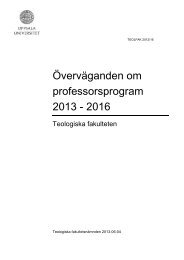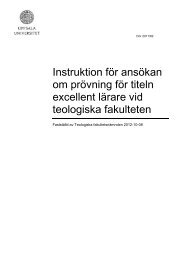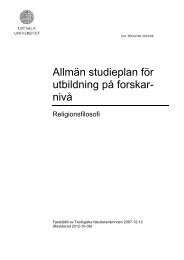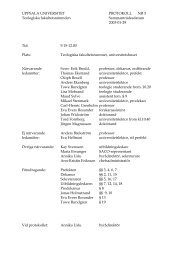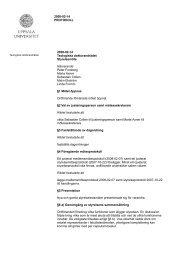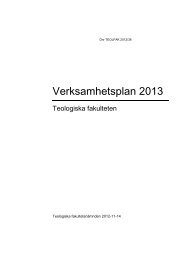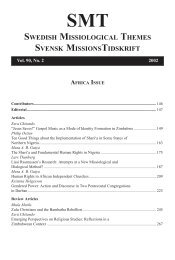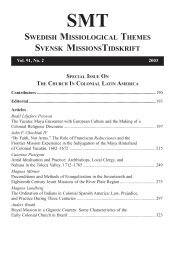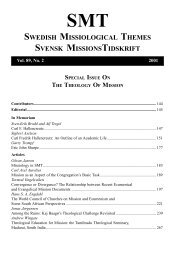SWEDISH MISSIOLOGICAL THEMES SVENSK MISSIONSTIDSKRIFT
SWEDISH MISSIOLOGICAL THEMES SVENSK MISSIONSTIDSKRIFT
SWEDISH MISSIOLOGICAL THEMES SVENSK MISSIONSTIDSKRIFT
Create successful ePaper yourself
Turn your PDF publications into a flip-book with our unique Google optimized e-Paper software.
508 Aasulv Lande<br />
Swedes to Emperor Ludwig, stating that many wanted to join the new faith;<br />
the King even wanted to have “suitable priests”. Through the Abbot in Corbie,<br />
Ansgar was commended to the task. So the calling to the missionary vocation<br />
is to a great extent the result of co-operation between church and state. And<br />
note! It is legitimised by a request from the mission country. 5<br />
Status<br />
Ansgar, who already had undertaken a missionary tour to Denmark, now<br />
prepared for the first journey to Sweden, to Birka in mid-Sweden,<br />
traditionally dated 830. His career as a missionary and in the ecclesiastical<br />
hierarchy advances simultaneously. The missionary’s legitimacy in<br />
Rimbert’s thinking comes from his position in the hierarchy of the Church.<br />
After a year and a half in Birka, he returned to Emperor Ludwig was made<br />
Bishop of Hamburg. Hamburg was not any town. It was a small see, but<br />
significant and dangerous. Hamburg had the missionary power in the whole<br />
Church and for the whole Church north of the River Elbe. It is the work of<br />
Christ and the apostolic expansion in Ultima Thule that becomes its task.<br />
The bishopric was assigned a monastery of its own in Gallia (Torhout) for<br />
its support. Yet another factor added to the legitimisation of Ansgar. Through<br />
a reception, a papal bull and by giving him a pallium, Ansgar is appointed<br />
missionary to many peoples: Swedes, Danes, slaves and others in the north.<br />
That task was given to Ansgar and to the Archbishop Ebo of Reims.<br />
Conflict motives<br />
The whole missionary endeavour of Ansgar was marked by and interpreted<br />
as a war against the Devil. Bishop Gautbert in Birka is persecuted and<br />
becomes a martyr and the see of Hamburg is in 852 burnt by Vikings. All<br />
these conflicts are contests showing who is the strongest. Christ or the<br />
local Gods. It is told how a Swedish army in the Baltic6 does not receive<br />
help from their ancient Gods. 7 By drawing of lots, the Swedish army decided<br />
that Christ would help them and they gathered their forces again. That<br />
attack was, however, never completed since peace was made with the Baltic<br />
5 The strength of the political motifs on the Swedish side is difficult to decide. None the<br />
less it is part of Rimberts mission theology.<br />
6 The war on Kurland<br />
7 Rimbert 1986: 58 pp.



